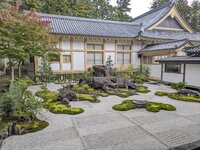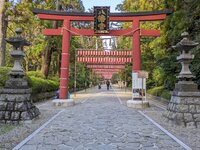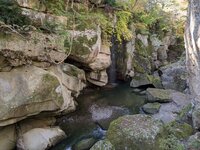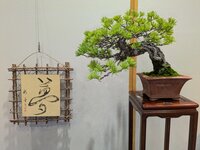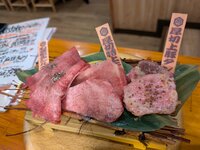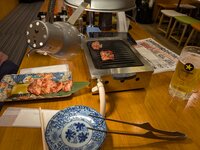The journey from Kesennuma to Sendai involved three trains (again). This time, the JR Ofunato line to the amusingly named Ichinoseki, followed by Ichinoseki to Kogota on the Tohoku local line and the Kogota to Sendai local train. The first connection was over an hour. The second was 5 mins! As always, 5 mins was plenty of time to change trains due to punctuality and excellent signage.
Our arrival at Sendai station reminded was a bit of a rude awakening. Travelling around the relatively quiet north, we had forgotten what chaos a big city train station can be like in Japan. It didn't help that it was raining, so it took us a while to find our way out and on the right road to the hotel.
Sendai

Sendai seems to have suffered more from the 2011 quake itself than from the subsequent tsunami, although the neighbouring coastal town of Matsushima took a bit of a hit. It appears as though the size of the sea defences being constructed is proportional to the damage that was sustained. This seems like a bold strategy, but one assumes these people know what they are doing. Ironically, the most damage we came across during our stay in Sendai was to the Edo period castle whose remaining stone walls largely collapsed during the quake. The Shogunate weren't to know; although they did generally build their castles out of wood which can withstand an earthquake. Such structures are not so good against heavy bombing though which happened in 1945 and is why there is no castle here. These guys sure do take a beating!.
A day out to the seaside saw us visiting the aforementioned town of Matsushima... along with all the other day trippers and holiday-makers. One can tell this is a tourist town as the seagulls are very partial to ice-cream. Matsushima Bay is a bit remeniscent of Halong Bay in Vietnam, studded as it is with rocky outcrops. There are boat tours aplenty (and Chinese tourists to fill them). There is a bunch of little shrines dotted about the place along with the rather larger Zuiganji Temple. The temple did have a couple of nice gravel gardens which are a feature of these places. The Buddhists also seem to own a 250m long bridge out to Fukuurajima Island since one can pay 250¥ to walk across it.
We changed hotels on the fly having realised that the one we had booked here had a really small room. It is becoming apparent that we have checked in to a Chinese hotel. The place is large and we are the only western guests. One can also tell from the behaviour at breakfast time, but the less said about that the better. We are trying to eat at the local spots, but it is hard as ever to figure out what to order. Last time, we found most places had electronic ordering along with tablets that could be run in English. This time, not so much. Also, most people do not seem to have much command of English - which is fair enough, but doesn't make the process any easier. We did manage to sample the local speciality which is Tongue and ended up in a restaurant where we were provided with a grill and had to cook the meat ourselves. It is hard to bring your culinary skills to bear on a product you've never eaten before. We are still alive.
Yamadera

A day trip out to Yamadera saw us on another local train. A very scenic one that wound through
the mountains to the west of Sendai to a small village. The reason for coming here is the collection
of Buddhiist temples arranged on the side of a mountain. The approach to the temples is demarked by
1000 Chinese touristssteps. The steps wind up the cliff past weird rock formations,
numerous small temples and multiple opportunities to donate money. Since this is a Buddhist site,
there is also an entry fee. The trip was worth it for the train journey alone, but the views from
the temples and lookout points were impressive. The autumn colours are late this year, but they are
now developing nicely.
After our experiences on the Michinoku Trail, 1000 steps did not seem too onerous, but it is certainly getting more busy here despite the fact that Sendai is not really on the tourist circuit. It mainly seems to be coaches full of day trippers that we are meeting at the sites. It remains to be seen what happens when we travel south of Tokyo into the so-called Golden Triangle of tourism.
Akiu Onsen
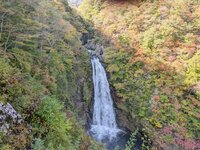
Encouraged by our day trips out, decided to be more ambitious and take a local bus out to an onsen town. This is ostensibly a place where there are lots of public baths fueled by hot springs. We managed to find the correct bus and even managed to purchase discounted return tickets. It went a bit wrong when we arrived in Akiu Onsen as we had decided to jump on another bus out to a local waterfall. So, jump on another bus we did. Inevitably, it turned out to be the wrong one. The situation was salvaged when we got off that bus at the next stopand discovered that the bus we should gave been on also stopped there. The waterfall was as one would expect. It was surrounded by early autumn foliage which made it more picturesque, but really, water cascading over a cliff is the same the world over and we have seen better.
The onsen town itself didn't seem very... onsony. We walked along a gorge and bought an overpriced coffee and we chatted with a local guy about his bonsai trees, but the main experience was getting there and back. We really were in the middle of rural Japan. A place that foreign tourists don't visit. OK, so there's a good reason, but it was still good to see. Apparently, some of the large hotels here have baths, but we didn't bother with the hassle of that.
Some Pictures

